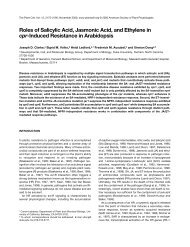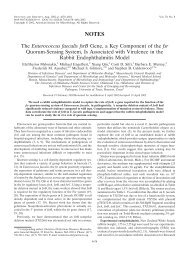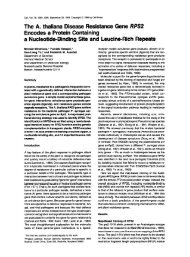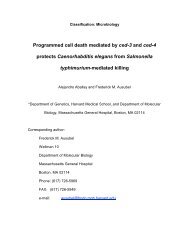Killing of Caenorhabditis elegans by Pseudomonas aeruginosa ...
Killing of Caenorhabditis elegans by Pseudomonas aeruginosa ...
Killing of Caenorhabditis elegans by Pseudomonas aeruginosa ...
You also want an ePaper? Increase the reach of your titles
YUMPU automatically turns print PDFs into web optimized ePapers that Google loves.
Microbiology: Tan et al. Proc. Natl. Acad. Sci. USA 96 (1999) 717<strong>elegans</strong> die over a period <strong>of</strong> 2.5–3 days when feeding on a lawn<strong>of</strong> PA14 grown on NG agar. Similar results were obtained onminimal M9 agar (not shown). The rate <strong>of</strong> killing was quantified<strong>by</strong> determining the LT 50 ; adults are more susceptiblethan L4 stage worms (LT 50 37.8 2.4 h and 48.3 1.8 h,respectively; Fig. 1A).In contrast to the killing <strong>of</strong> C. <strong>elegans</strong> observed on NG andM9 media, when PA14 is grown on PGS agar, a richer medium<strong>of</strong> higher osmolarity, the L4 larval stage worms die within 4–24h (Fig. 1B). We define the killing <strong>of</strong> C. <strong>elegans</strong> described in theprevious paragraph that uses NG and M9 media as slow killingand the more rapid killing on PGS agar as fast killing. Incontrast to slow killing, L4 worms are dramatically moresusceptible to fast killing than 1-day-old adults (Fig. 1B).We tested several P. <strong>aeruginosa</strong> strains for their ability to killC. <strong>elegans</strong> under both fast-killing (PGS media) and slow-killing(NG media) conditions. As shown in Fig. 1C, among the P.<strong>aeruginosa</strong> strains tested for slow killing, PA14 was the mostlethal to adult C. <strong>elegans</strong> (LT 50 37.8 h); PAO1 (LT 50 68.2 h) and PA29 (LT 50 61.5 h) were moderately lethal; andPO37 and PAK did not kill. No slow killing was also observedwith E. coli OP50, with the phytopathogen P. syringae pv.maculicola strain ES4326, or with several P. fluorescens strains(WCS365, 55 and 2-79; not shown). In the case <strong>of</strong> the nonlethalstrains, including P. <strong>aeruginosa</strong> strains PO37 and PAK, C.<strong>elegans</strong> was able to undergo normal development and reproduction;a healthy brood consisting <strong>of</strong> hundreds or thousands<strong>of</strong> progeny was produced <strong>by</strong> day 4 from an initial foundingpopulation <strong>of</strong> 10 worms, and the entire lawn <strong>of</strong> bacteria wasconsumed. In contrast, the few progeny that were seen inpopulations <strong>of</strong> worms fed on P. <strong>aeruginosa</strong> PA14 eventuallydied, and the bacterial lawn remained intact.As shown in Fig. 1D, PA14 was also the most effective P.<strong>aeruginosa</strong> strain tested at fast killing L4 stage C. <strong>elegans</strong>.Similarly to slow killing, E. coli OP50, P. syringae pv. maculicolaE4326, and P. fluorescens 55 also did not kill under fast-killingconditions (not shown). On the other hand, P. fluorescensstrains 2-79 (Fig. 1D) and WCS365 (not shown) killed C.<strong>elegans</strong> at the same rate as PA14 on PGS medium. We choseP. <strong>aeruginosa</strong> strain PA14 for further studies, because it was themost lethal in both the fast- and slow-killing assays.No killing <strong>of</strong> C. <strong>elegans</strong> was observed under slow-killingconditions when they were fed heat-killed (Fig. 1E) or antibiotic-killed(not shown) PA14; the worms produced normalbroods, which completely consumed the bacterial lawn, showingthat PA14 is nutritionally adequate to support the growthand development <strong>of</strong> C. <strong>elegans</strong>. In contrast, heat-killed bacteriastill killed as efficiently as the nonheated controls underfast-killing conditions (Fig. 1E), suggesting that fast killingmay be mediated at least in part <strong>by</strong> an excreted heat-stablePA14 toxin(s).Some Virulence Determinants Required for P. <strong>aeruginosa</strong>Pathogenesis in Plants and Mice Are Also Essential for <strong>Killing</strong>C. <strong>elegans</strong>. To determine whether the molecular mechanismsunderlying slow and fast killing <strong>of</strong> C. <strong>elegans</strong> <strong>by</strong> P. <strong>aeruginosa</strong>PA14 are similar to the mechanisms involved in mammalianand plant pathogenesis, we tested two categories <strong>of</strong> PA14mutants in the nematode-killing models. The first category <strong>of</strong>mutants contained mutations in three known P. <strong>aeruginosa</strong>virulence factors, gacA, toxA, and plcS, that we had constructedpreviously <strong>by</strong> a marker-exchange process (11). plcS encodes ahemolytic phospholipase C (33), and toxA encodes exotoxin A,an ADP-ribosyltransferase that inactivates eukaryotic elongationfactor 2 (34). GacA is a two-component response regulatorand in P. <strong>aeruginosa</strong> serves as a global activator <strong>of</strong> thesynthesis <strong>of</strong> cyanide, lipase, pyocyanin, and the autoinducerN-butyrylhomoserine lactone (35). We showed previously thatgacA, toxA, and plcS are required for full pathogenicity <strong>of</strong>PA14 in both a mouse-burn model and in an Arabidopsis-leafinfiltration model (11).The second category <strong>of</strong> PA14 mutants that we tested in theC. <strong>elegans</strong> killing assays consisted <strong>of</strong> a set <strong>of</strong> nine TnphoAgeneratedPA14 mutants that had been identified on the basis<strong>of</strong> reduced pathogenicity in a plant-leaf infection assay. Two <strong>of</strong>these nine mutants, ID7 and pho15, correspond to TnphoAinsertions in the gacA and dsbA genes, respectively. dsbAencodes a periplasmic disulfide bond-forming enzyme (36).The other seven mutants contained TnphoA insertions in genesthat either had not been described previously or that were notknown to be involved in virulence. All nine TnphoA mutants,with the possible exception <strong>of</strong> 16G12, were reduced significantlyin pathogenicity in the mouse-burn model (12).As summarized in Table 1 and shown in part in Fig. 2,mutations in six different PA14 virulence-related genes [toxA,34H4, 25F1, dsbA(pho15), gacA (ID7), and pho34B12] affectedslow killing <strong>of</strong> C. <strong>elegans</strong>, and two mutants [dsbA(pho15) andpho34B12] affected fast killing. Fig. 2 A and B shows thatmutations in the PA14 gacA gene, including a construct(SW7-4) that is nonpolar on the downstream uvrC gene (12),were severely defective in their ability to kill C. <strong>elegans</strong> underslow-killing conditions (LT 50 90 h) but had no detectableeffect on the rate <strong>of</strong> fast killing. Fig. 2 C and D shows that thedsbA mutant is delayed moderately in both slow and fastkilling, and Fig. 2 E and F shows that mutant pho34B12 isaffected severely in fast killing and affected moderately in slowkilling. The toxA, 34H4, and 25F1 mutants exhibited highlyreproducible but moderate delays in slow killing and nodifferences from wild type in fast killing (not shown).The observations that mutations in gacA affected only slowkilling (Fig. 3 A and B) and that the TnphoA insertion inpho34B12 primarily affected fast killing (Fig. 3 E and F)suggest that fast killing is not simply an acceleration <strong>of</strong> theprocess seen in slow killing. The data indicating that heatkilledbacteria are still capable <strong>of</strong> fast but not slow killing areconsistent with the conclusions that fast and slow killing maybe mechanistically distinct and that PA14 employs differentmechanisms in killing C. <strong>elegans</strong> depending on the medium inwhich the bacteria are grown. To explore the mechanism <strong>of</strong>PA14-mediated slow killing <strong>of</strong> C. <strong>elegans</strong> further, we designedexperiments described below to determine whether slow killinginvolves an active infectious process. We have shown that fastTable 1.<strong>Killing</strong> <strong>of</strong> C. <strong>elegans</strong> <strong>by</strong> P. <strong>aeruginosa</strong> PA14 mutantsStrainSlow-killingconditions*Fast-killingconditions †PA14 33A9 33C7 25A12 16G12 plcS toxA 25F1 34H4 gacA (polar insertion ‡ ) gacA SW7.4 (nonpolar insertion § ) ID7 (gacA::TnphoA) pho15 (dsbA::TnphoA) pho34B12 *Rate <strong>of</strong> slow killing relative to wild-type PA14: , indistinguishable(LT 50 48–53 h); , moderately reduced (LT 50 55–70 h); and ,severely reduced (LT 50 90 h).† Rate <strong>of</strong> fast killing relative to PA14: , indistinguishable (percentage<strong>of</strong> mortality at 12 h, % 12 80); , moderately reduced (% 12 25–80); and , severely reduced (% 12 25).‡ The gacA gene is interrupted <strong>by</strong> a cassette conferring gentamycinresistance and is polar to the downstream uvrC gene (11).§ A kanamycin cassette is inserted in-frame into the gacA gene, suchthat the translation <strong>of</strong> uvrC is reinitiated <strong>by</strong> the 3 end <strong>of</strong> the cassette(12).
Microbiology: Tan et al. Proc. Natl. Acad. Sci. USA 96 (1999) 719FIG. 4. Fluorescence micrographs <strong>of</strong> worms fed on PA14GFP(B), DH5GFP (D), and gacA SW7-4GFP (F) for 48 h. The cellularstructures <strong>of</strong> the same worms visualized under Nomarski phasecontrast are shown in A, C, and D, respectively. (B) The entire lumen<strong>of</strong> worms fed on PA14GFP was filled with GFP-expressing PA14.PA14GFP began to accumulate after 36 h <strong>of</strong> feeding. In contrast, thelumen <strong>of</strong> worms feed on DH5GFP (D) and gacA SW7-4GFP (F)showed no detectable GFP (see arrows), indicating that very few, ifany, <strong>of</strong> the nonpathogenic bacteria were present. The intestinal cellswere highly fluorescent in D and E because <strong>of</strong> aut<strong>of</strong>luorescence. ForgacA SW7-4GFP, GFP expression was detected at 72 h. The micrographsfor PA14GFP are shown at 400 magnification, whereas themicrographs for DH5GFP and gacA SW7-4GFP are at 160magnification.Because PA14-mediated killing <strong>of</strong> C. <strong>elegans</strong> seems torequire active replication <strong>of</strong> PA14 in the worm intestine, wereasoned that decreasing the rate <strong>of</strong> PA14 replication <strong>by</strong>feeding on PA14 at lowered temperatures might spare theworms. Therefore, plates containing PA14 lawns grown for24 h at 37°C were seeded with worms and subsequentlyincubated at 15 or 25°C; the generation time <strong>of</strong> PA14 on NGmedia at 15°C is about 5.2 times longer than at 25°C (notshown). Over 95% <strong>of</strong> worms were dead after 60 h at 25°C butno mortality was seen in plates incubated at 15°C (not shown).These data suggested that the attenuated killing at 15°C is aconsequence <strong>of</strong> the slower growth rate <strong>of</strong> PA14.To rule out the possibility that a slower rate <strong>of</strong> bacterialconsumption at 15°C was the cause <strong>of</strong> decreased killing, wecompared the killing <strong>of</strong> wild-type and eat-1(ad427) worms <strong>by</strong>PA14 at 25°C. The eat-1 mutant has a defect in pharyngealmuscle motion and consequently pumps more slowly than wildtype, consuming bacteria at a slower rate (40). As shown in Fig.3B, no difference in killing rate was observed between eat-1and N2 adults. This result provides further evidence that therate <strong>of</strong> killing <strong>by</strong> PA14 is a function <strong>of</strong> the establishment andproliferation <strong>of</strong> bacteria within the gut and is independent <strong>of</strong>the rate at which bacteria enter the gut.DISCUSSIONP. <strong>aeruginosa</strong> is an opportunistic pathogen <strong>of</strong> vertebrates anda primary pathogen <strong>of</strong> insects. There are also sporadic reportsthat P. <strong>aeruginosa</strong> can elicit disease in a variety <strong>of</strong> plants. In thispaper, we have shown that various P. <strong>aeruginosa</strong> strains canalso kill C. <strong>elegans</strong>. The C. <strong>elegans</strong>–P. <strong>aeruginosa</strong> pathogenesismodels that we have developed use a strain <strong>of</strong> P. <strong>aeruginosa</strong>,PA14, that we have previously shown to be a pathogen <strong>of</strong> bothplants and mice. To the best <strong>of</strong> our knowledge, there are noother reported examples in which a single strain <strong>of</strong> a bacterialpathogen can establish a pathogenic interaction with so manyevolutionarily diverse hosts.Interestingly, we have shown that PA14 most likely kills C.<strong>elegans</strong> <strong>by</strong> at least two distinct underlying mechanisms: slowkilling, which requires the consumption <strong>of</strong> live bacteria and iscorrelated with the proliferation <strong>of</strong> live bacteria in the wormgut, and fast killing, which does not require live bacteria andis therefore most likely mediated <strong>by</strong> exported toxins. Althoughthe data in Figs. 3 and 4 suggest that slow killing involves aninfectious process, they do not rule out the possibility thatPA14 proliferation in the C. <strong>elegans</strong> gut is a consequence ratherthan the cause <strong>of</strong> killing. In the case <strong>of</strong> fast killing <strong>by</strong> testingisogenic toxA and plcS mutants <strong>of</strong> PA14, we showed that twoknown toxins, the hemolytic phospholipase C and exotoxin A,are not essential for killing worms under the fast-killingconditions. Consistent with this conclusion, we have shownthat fast killing is mediated at least in part <strong>by</strong> phenazines, lowmolecular-weight diffusible toxins excreted <strong>by</strong> P. <strong>aeruginosa</strong>(37). The observation that two P. fluorescens strains were aslethal as PA14 in fast killing but were not pathogenic underslow-killing conditions is consistent with the conclusion thatfast and slow killing are mechanistically distinct.Our observation that some but not all strains <strong>of</strong> P. <strong>aeruginosa</strong>kill C. <strong>elegans</strong> is consistent with previous reports that someunspecified strains <strong>of</strong> P. <strong>aeruginosa</strong> are able to support growthand reproduction <strong>of</strong> C. <strong>elegans</strong> (18, 41). These observations arealso consistent with the fact that different strains <strong>of</strong> P. <strong>aeruginosa</strong>have been shown to exhibit varying degrees <strong>of</strong> virulencein different mammalian (11, 42) and plant (11, 12, 14) infectionmodels.Importantly, several nonessential P. <strong>aeruginosa</strong> genes includingtoxA, gacA, and dsbA that are involved in pathogenicinteractions in mice and plants are also required for themaximally effective killing <strong>of</strong> C. <strong>elegans</strong>. From an evolutionaryperspective, the identification <strong>of</strong> many common virulencedeterminants required for pathogenesis in three distinctgroups <strong>of</strong> organisms—plants, invertebrates, and vertebrates—provides firm experimental evidence that the molecular basis<strong>of</strong> P. <strong>aeruginosa</strong> pathogenicity may be conserved in threeevolutionarily divergent hosts. For example, the requirement<strong>of</strong> exotoxin A for full virulence in plant, nematode, andmammalian hosts suggests that these evolutionarily distantorganisms have conserved not only the target for this ADPribosylatingtoxin but may have also conserved the receptor forthe toxin and the transport <strong>of</strong> the toxin into the host cells.The development <strong>of</strong> the C. <strong>elegans</strong>–P. <strong>aeruginosa</strong> pathogenesismodel enables the application <strong>of</strong> systematic genetic analysisto study the interaction between a bacterial pathogen andan animal host from the perspectives <strong>of</strong> both the pathogen andthe host. Importantly, because P. <strong>aeruginosa</strong> mutations thataffect fast or slow killing <strong>of</strong> C. <strong>elegans</strong> also affect mousepathogenesis, both fast and slow killing seem to be relevantmodels <strong>of</strong> various aspects <strong>of</strong> mammalian pathogenesis. Wehave already used the C. <strong>elegans</strong>–P. <strong>aeruginosa</strong> model toidentify P. <strong>aeruginosa</strong> PA14 mutants that are impaired in fast(37) or slow (M.-W.T. and F.M.A., unpublished work) killingand have found that many <strong>of</strong> these mutants are also lesspathogenic in a mouse-burn model. In addition, we haveisolated C. <strong>elegans</strong> mutants that are more resistant to both fastand slow killing and C. <strong>elegans</strong> mutants that are more susceptibleto slow killing (M.-W.T. and S.M.-M., unpublished data).Analysis <strong>of</strong> these latter mutants would help dissect the complexmechanisms involved in the host response to pathogen attack.Finally, our laboratory has also shown that P. <strong>aeruginosa</strong> strainPA14 is a potent pathogen <strong>of</strong> several insects, including D.melanogaster, Galleria mellonella (greater wax moth), and








